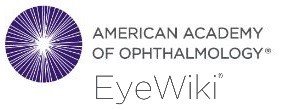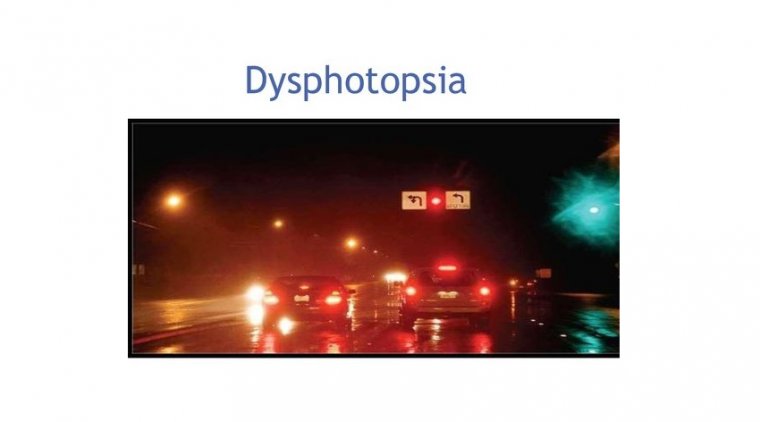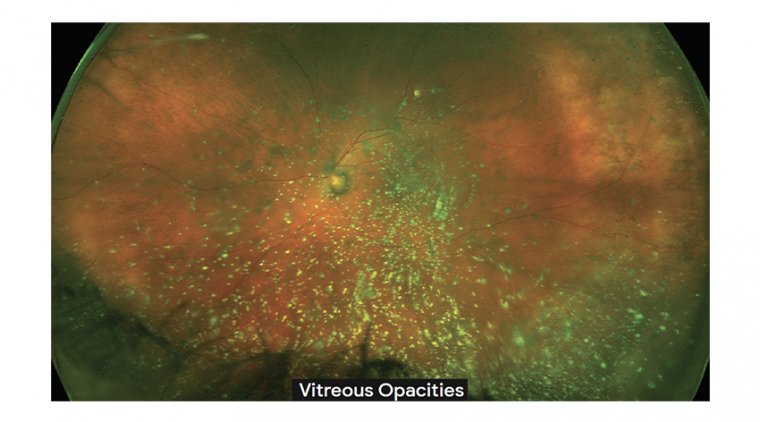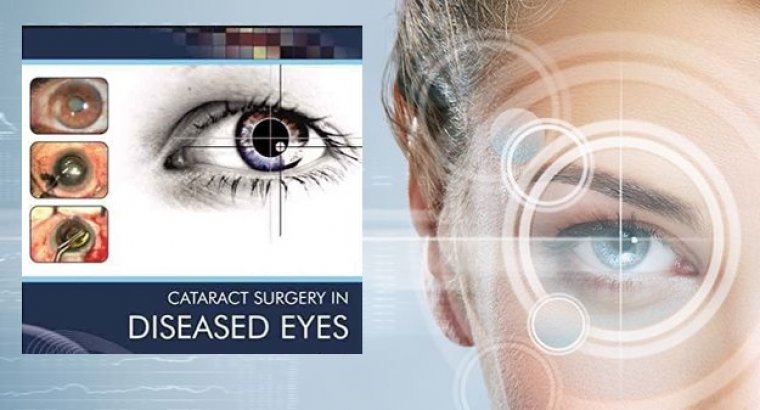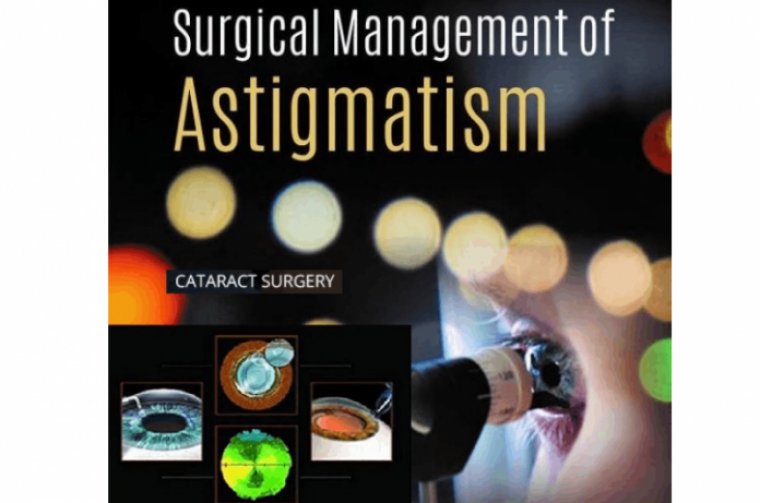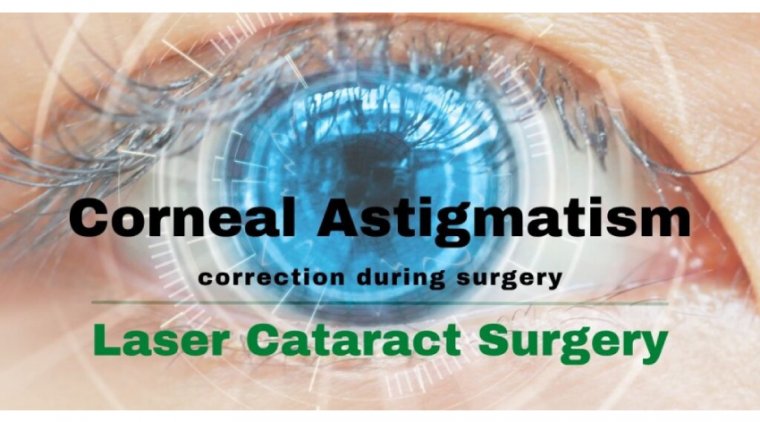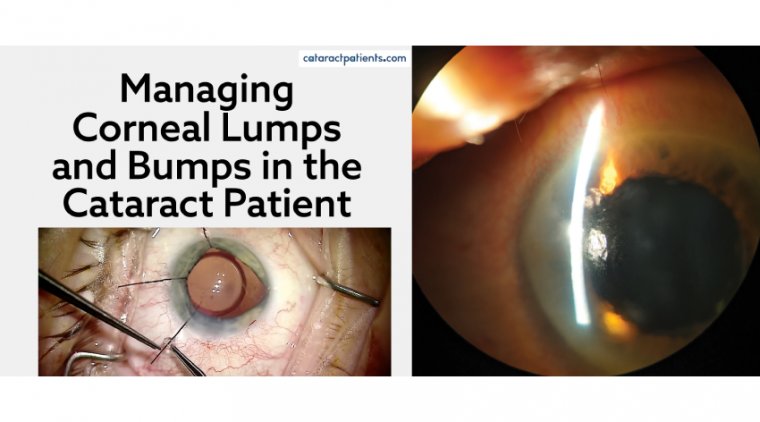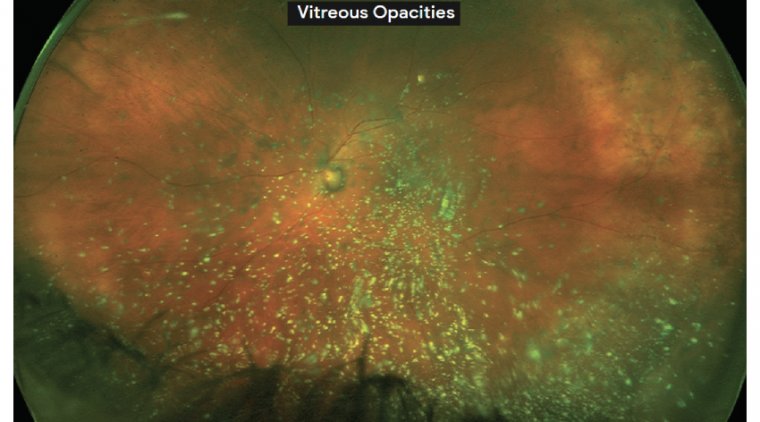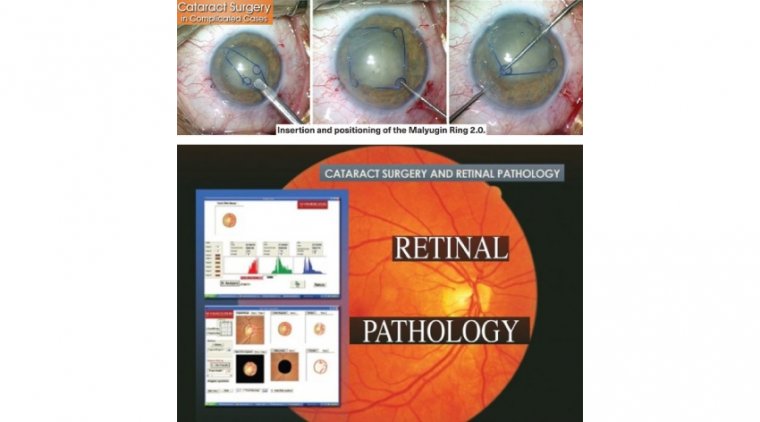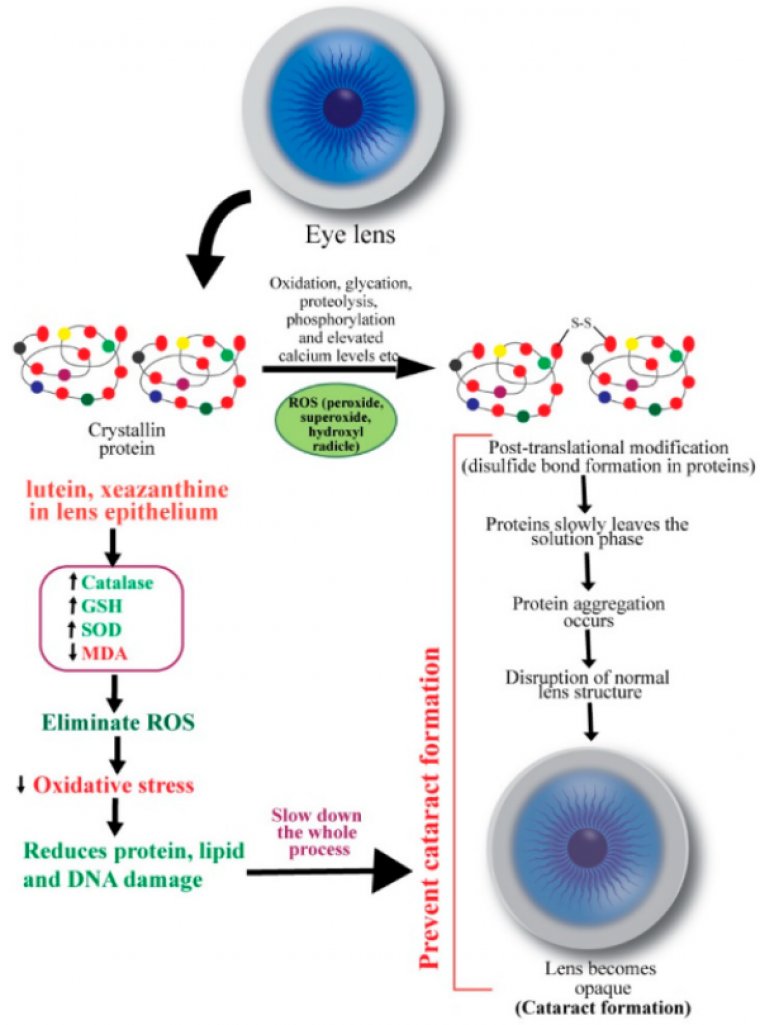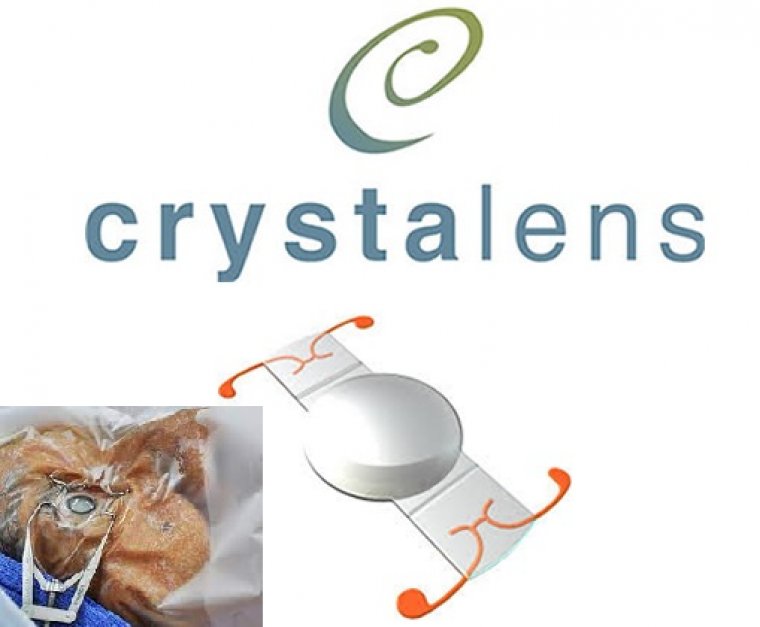
Crystalens & Cataract Surgery
Ophthalmology News - “The word ophthalmos, “οφθαλμος” from which the term ophthalmology is derived, appears often in Homer’s epic poetry: “Athena aimed the arrow towards the nose, near the ophthalmos [eye] and pierced the white teeth” [Il 5.291].”
The Crystalens is an FDA-approved intraocular lens for the visual correction of adults with cataracts (clouding of the eye's natural lens secondary to age) with or without presbyopia, or lenses that have aged or become more rigid.
Crystalens AO Lens is an artificial lens implant that can treat both cataracts and presbyopia —the clouding or hardening of lenses, and the loss of near and intermediate vision, respectively.
Crystalens was modeled after the human eye. Like the natural lens, it is a lens implant that uses the eye muscle to flex and accommodate in order to focus on objects in the environment at all distances.
Ophthalmic News - Inflections of Vision-Illumination-Emanation! Intersection of the energies streaming from the infinite dimensions and intelligent infinity.
Crystalens dynamically adjusts to your visual needs. Many patients will have greater freedom from glasses after surgery, but you may still need reading glasses for small print or other near vision tasks.
Crystalens AO is implanted during one of the most commonly performed surgeries in the world. Over 3 million cataract surgeries are performed in the US every year.
WHAT PATIENTS NEED TO KNOW ABOUT CRYSTALENS
Dr. Singh: Educating patients upfront is an important aspect of cataract surgery. When I discuss the Crystalens IOL with patients, I emphasize what the lens is supposed to do and why I’m recommending it.
Ophthalmology News. - Transmutes all creation and our lives into something precious and sacred, to be loved, embraced, cherished and celebrated because the life we see and experience here is the emanation of the divine ground. Illumination Of The Great Architect of The Universe…
I tell them: “Based upon your eye and your health, I believe this lens will give you the highest quality of vision. It’s one of the only lenses we have today that’s designed to emulate your natural lens by adjusting its movement in the eye to give you a range of vision.
It’s not meant to give you the close-up vision you had when you were 20 years old. It’s meant to give you a range of distance and intermediate vision, and it might give you more reading vision.”
Ophthalmology – Illumination Through All Seeing Eye Of The Great Architect of The Universe…
When I explain to patients that Crystalens is designed to deliver excellent quality distance and intermediate vision and they may need reading glasses occasionally, they accept that.
If you, as the surgeon, don’t feel that’s a big deal, patients usually don’t either. I think the key to a patient’s understanding and acceptance is the surgeon’s confidence in explaining what the lens is meant to do, not focusing on what it cannot do, which is J1 for every patient.
Patients trust us to recommend the right lens for them.
Ophthalmic News - Inflections of Vision-Illumination-Emanation! Intersection of the energies streaming from the infinite dimensions and intelligent infinity.
Y. Ralph Chu, MD: Cataract surgeons were introduced to the world’s first accommodating IOL in 2003. Since then, the Crystalens (Bausch + Lomb) has undergone significant advancements—a fifth generation was introduced in 2010—while retaining its unique position as the only accommodating IOL.
Even as they’ve embraced advanced multifocal technology, many refractive cataract surgeons, our panelists among them, still consider Crystalens to be an important option that enables them to deliver the quality of vision their patients expect.
Dr. Desai, why is Crystalens still a first-line choice in your practice?
Ophthalmology – Illumination Through All Seeing Eye Of The Great Architect of The Universe…
Emphasis on Quality of Vision
Neel R. Desai, MD: If we are to consider ourselves refractive cataract surgeons, we need to use all of the tools in our toolbox to achieve the desired outcomes. Despite the burgeoning availability of new technologies in this arena, Crystalens remains a strong presence in my practice.
I think it would be disingenuous to say that Crystalens is the dominant player, because there really is no dominant player. I use all of the technologies.
I think it’s incumbent upon all of us and our colleagues around the country and around the world, to choose the best technology and achieve the best outcomes for each patient, so I tend to lean on Crystalens even more now.
Ophthalmology – Illumination Through All Seeing Eye Of The Great Architect of The Universe…
Mitchell C. Shultz, MD: In my personal experience, there are definitely some unique patients where Crystalens is an excellent choice. Post-radial keratotomy (RK) eyes, for example, are some of the more complicated cases where diffractive optics are absolutely contraindicated.
Crystalens is the go-to IOL for me in those situations.
Dr. Desai: Indeed, Crystalens is my lens of choice for patients who have complex corneas, dry eye, imperfect maculas, mild glaucoma, or personalities that aren’t ideal for diffractive optics or other types of refractive optics.
Ophthalmology News - “The word ophthalmos, “οφθαλμος” from which the term ophthalmology is derived, appears often in Homer’s epic poetry: “Athena aimed the arrow towards the nose, near the ophthalmos [eye] and pierced the white teeth” [Il 5.291].”
That’s why I chose it for my father, who’s a surgeon himself and, admittedly, a type A++ personality. It was my clear, easy choice because I wanted him—and all of my patients—to achieve excellent distance vision with minimal dysphotopsias.
When I’m choosing a lens, I’m looking at how I can achieve the safest, best outcome with the least amount of downside.
Ophthalmic News - Inflections of Vision-Illumination-Emanation! Intersection of the energies streaming from the infinite dimensions and intelligent infinity.
Paul Singh, MD: We definitely need to be open-minded and avail ourselves of all possible options for our patients. Οφθαλμός
To me, as a glaucoma specialist, it’s analogous to MIGS. Right now, we have many different MIGS procedures, and each potential patient might require a different procedure, based on anatomy, physiology, disease severity, and so on.
It’s the same with IOLs. When I’m evaluating a patient, I’m thinking about what’s best for that patient. After utilizing diffractive IOLs and all of the extended-depthof-focus (EDOF) lenses, I’ve realized that patients don’t want to compromise on quality of vision, nor do I.
Ophthalmology News. - Transmutes all creation and our lives into something precious and sacred, to be loved, embraced, cherished and celebrated because the life we see and experience here is the emanation of the divine ground. Illumination Of The Great Architect of The Universe…
For many, Crystalens is a great option. I love its versatility. With Crystalens, if the refractive power is off for some reason, I can always correct it. With diffractive optics, if a patient isn’t happy with his or her quality of vision, not much can be done.
At the end of the day, quality of vision is what’s important to patients, not necessarily J1 or J2. For an unpublished study we conducted in our practice, we offered patients two options. We said, “One lens can give you great distance and intermediate vision, with very little glare and halos.
The other lens will give you distance, intermediate, and reading vision, with a slightly higher risk of some arcs around lights and glare and halos.
Ophthalmic News - Inflections of Vision-Illumination-Emanation! Intersection of the energies streaming from the infinite dimensions and intelligent infinity.
Which would you prefer?” An overwhelming majority, 86%, of the patients we polled preferred distance and intermediate vision with minimal compromise in the quality of vision.
Don’t get me wrong. Diffractive multifocals have been greatly improved over the years. There’s no doubt about that. But when I’m really concerned about a patient’s quality of vision, I find myself going back to the Crystalens.
Impact of Today’s Lifestyle on Vision
Dr. Chu: Dr. Shultz, do lifestyle issues play a role in your lens choices, particularly in Southern California where you practice?
Dr. Shultz: In Southern California, it’s not unusual for people to commute one or two hours to and from work—certainly pre-COVID and probably postCOVID, as well—so driving at night is a huge factor, and this is true not only for people who are working but also for active retirees.
Ophthalmic News - Inflections of Vision-Illumination-Emanation! Intersection of the energies streaming from the infinite dimensions and intelligent infinity.
The potential for glare and halos at night is a real issue. What’s more, most people today are not reading printed text. They’re using iPads and smartphones and expanding the text to read. So the need to see J1 is low.
The trade-off with some of the new multifocals is that patients are giving up a line of distance vision to achieve J1 vision, whereas in my experience with Crystalens and Trulign, we are able to maintain excellent distance acuity while minimizing compromise to night vision, and still have the majority of our patients seeing J2 to J4 near and intermediate.
That’s exactly where my Crystalens patients are. And, based on a presentation by Dr. Eva Liang, 80% of patients were in the J3 intermediate zone.
Ophthalmology News - “The word ophthalmos, “οφθαλμος” from which the term ophthalmology is derived, appears often in Homer’s epic poetry: “Athena aimed the arrow towards the nose, near the ophthalmos [eye] and pierced the white teeth” [Il 5.291].”
Dr. Desai: Dr. Shultz’s comment about the use of electronic devices reminded me of another issue. Many people, particularly during the COVID era, are experiencing increased screen time demand, spending most of their day viewing a variety of backlit LED devices—computer monitors, laptops, cell phones, e-tablets, and the like.
Οφθαλμός Οφθαλμολογικά Νέα όλοι βλέπουν τα μάτια του θεού όλα βλέπουν τα μάτια
I think it’s important to point out that positive dysphotopsias don’t occur only when people are driving at night.
With the combination of diffractive optics, the backlit surface of a computer or e-reader, plus, potentially, ocular surface disease exacerbated by prolonged screen time, there’s a good chance patients will experience positive dysphotopsias in addition to issues that arise from spherical aberrations.
Ophthalmic News - Inflections of Vision-Illumination-Emanation! Intersection of the energies streaming from the infinite dimensions and intelligent infinity.
This makes Crystalens a better, sounder option than diffractive optics for many patients. Dr. Singh: We’re also noticing that patients are reporting floaters more often now with these backlit white screens.
With multifocality, floaters have become a big issue with contrast sensitivity. We’re seeing a significant increase in higher-order aberrations (HOAs) and decreased modulation transfer functions (MTFs) with floaters and multifocal lenses, upon examination with the iTrace aberrometer (Tracey Technologies).
Benefits of this Unique Design
Dr. Desai: The impact of spherical aberrations on longterm quality of vision is an important topic to discuss.
Most modern presbyopia-correcting IOLs are designed with negative asphericity built into an aspheric platform, whereas the Crystalens has neutral asphericity, which makes it more forgiving of HOAs, coma, and the decentration that occurs naturally over time.
Ophthalmic News - Inflections of Vision-Illumination-Emanation! Intersection of the energies streaming from the infinite dimensions and intelligent infinity.
Unlike single-piece IOLs designed with two haptics and three points of contact, the Crystalens has five points of contact, making it less likely to rotate as a result of capsular contraction.
Also noteworthy—and a recent hot topic among cataract surgeons—is the phenomenon of glistenings.
Based on my experience, I believe back scatter from glistenings is a real issue with many of the hydrophobic acrylic lenses, and it does affect long-term quality of vision. With a silicone lens, we don’t have to worry about that.
Dr. Chu: Dr. Shultz, what features of the cornea are you most concerned about when choosing an IOL?
Ophthalmology News - “The word ophthalmos, “οφθαλμος” from which the term ophthalmology is derived, appears often in Homer’s epic poetry: “Athena aimed the arrow towards the nose, near the ophthalmos [eye] and pierced the white teeth” [Il 5.291].”
Dr. Shultz: I use the iTrace on every patient to analyze for corneal spherical aberrations and to look for HOAs, basically everything that could affect the performance of a lens, as well as features that we need to watch out for to make sure we don’t counsel patients improperly about other technologies.
Certainly, angle kappa, chord mu, and angle alpha are huge factors, particularly in hyperopes, in whom a lens could be perfectly centered, but the patient isn’t looking through the center of the lens.
If the patient has a diffractive lens, that’s a problem, because he or she is looking through the lens edge or a secondary ring, and visual acuity will be reduced. Crystalens is a spherically neutral, aberration-free lens, and the power is uniform across the lens.
Ophthalmology News. - Transmutes all creation and our lives into something precious and sacred, to be loved, embraced, cherished and celebrated because the life we see and experience here is the emanation of the divine ground. Illumination Of The Great Architect of The Universe…
As long as the patient is looking through the lens, he or she will see well, and that’s the bottom line. I believe the spherically neutral concept of an IOL is a huge advantage. In my opinion, it’s the best option for my patients, whether it’s Crystalens, Trulign, enVista, or enVista Toric.
Ophthalmology News - “The word ophthalmos, “οφθαλμος” from which the term ophthalmology is derived, appears often in Homer’s epic poetry: “Athena aimed the arrow towards the nose, near the ophthalmos [eye] and pierced the white teeth” [Il 5.291].”
I’m hard pressed to choose other lenses, unless there’s a specific reason why someone wants one.
Surgical Insights
Dr. Chu: Some surgeons believe the Crystalens is more difficult to manage intraoperatively than the single-piece platforms.
Dr. Desai, what are your thoughts on this?
Ophthalmology News. - Transmutes all creation and our lives into something precious and sacred, to be loved, embraced, cherished and celebrated because the life we see and experience here is the emanation of the divine ground. Illumination Of The Great Architect of The Universe…
Οφθαλμός Οφθαλμολογικά Νέα όλοι βλέπουν τα μάτια του θεού όλα βλέπουν τα μάτια
Dr. Desai: I find Crystalens an easy lens to implant. There are two potential negative outcomes. It may give a patient vision that is equivalent to a monofocal lens, which can be easily adjusted and enhanced. Or Z-syndrome may occur.
In the thousands of Crystalens IOLs that my partner and I have implanted, we’ve never seen Z-syndrome, a situation in which one haptic is bent forward and the other is bent back, owing to asymmetric forces acting on the lens.
Ophthalmic News - Inflections of Vision-Illumination-Emanation! Intersection of the energies streaming from the infinite dimensions and intelligent infinity.
I believe capsulorhexis size is an important factor in avoiding Z-syndrome. The size of my capsulorhexis is based on the size of the optic.
For femtosecond laser cases, I size a Crystalens capsulorhexis somewhat larger than I would for other IOLs (6 mm versus 5.5 mm), because with a femto capsulorhexis, I’m finding some fibrosis around the capsule edge.
Contraction of the posterior capsule might induce vector forces that could cause a shift or a Z. I rotate the lens until it finds a comfortable axis, and I make sure all four haptics are well-seated into the equator of the bag.
Ophthalmology News. - Transmutes all creation and our lives into something precious and sacred, to be loved, embraced, cherished and celebrated because the life we see and experience here is the emanation of the divine ground. Illumination Of The Great Architect of The Universe…
Οφθαλμός Οφθαλμολογικά Νέα όλοι βλέπουν τα μάτια του θεού όλα βλέπουν τα μάτια
If you do that, you’ll avoid Z-syndrome. Dr. Shultz: I use a different approach to avoid Z-syndrome and striae in the posterior capsule.
Ophthalmology – The science & influence of Great Architect Of The Universe - Illumination Through All Seeing Eye.
This may be helpful for surgeons just beginning to use Crystalens. Based on a presentation by Liang, I began implanting capsular tension rings (CTRs) in 100% of my Crystalens and Trulign cases.
In fact, I use CTRs in almost all of my cases to avoid striae, myopic shifts, and Z-syndrome. I don’t charge extra for a CTR, and frankly, the cost of the CTR and the lens is no different than the cost of some premium multifocals.
Dr. Desai: As a counterpoint, I would suggest that surgeons who may be reticent about trying Crystalens may be equally reticent about placing a CTR. That might be outside their comfort zone.
Ophthalmic News - Inflections of Vision-Illumination-Emanation! Intersection of the energies streaming from the infinite dimensions and intelligent infinity.
Οφθαλμός Οφθαλμολογικά Νέα όλοι βλέπουν τα μάτια του θεού όλα βλέπουν τα μάτια
I can accomplish the same excellent outcomes without a CTR. My modus operandi, as I described earlier, is capsulorhexis size along with early Nd:YAG capsulotomy, sometimes even within the global period, if I’m starting to see striae and contraction.
My capsulotomy in these cases is somewhat different from what I do ordinarily. It is relatively small in the short axis of the optic. I extend it from haptic optic junction to haptic optic junction in the long meridian and within 2 mm of the edge of the optic in the short axis.
I perform the capsulotomy within the global period, and doing so has prevented myopic shifts, hyperopic shifts, Z-syndrome, and a host of other issues. I don’t disagree with using a CTR, but it may be one extra step that new surgeons might be reluctant to employ on a routine basis.
Ophthalmology News. - Transmutes all creation and our lives into something precious and sacred, to be loved, embraced, cherished and celebrated because the life we see and experience here is the emanation of the divine ground. Illumination Of The Great Architect of The Universe…
Οφθαλμός Οφθαλμολογικά Νέα όλοι βλέπουν τα μάτια του θεού όλα βλέπουν τα μάτια
Dr. Shultz: I believe CTR placement is easy for young surgeons to learn, and, in my experience, I have found that it really does help reduce the need for YAG capsulotomies. I’ve found the FortifEYE CTR (Bausch + Lomb) is quite smooth and easy to insert.
It alleviates some concerns about capsule management, particularly when we’re comanaging patients and don’t necessarily see them in that early phase. The CTR, in my opinion, has made the Crystalens technology as easy to use as any other lens.
Ophthalmology News. - Transmutes all creation and our lives into something precious and sacred, to be loved, embraced, cherished and celebrated because the life we see and experience here is the emanation of the divine ground. Illumination Of The Great Architect of The Universe…
Dr. Desai: The take-home point that seems to be resonating with all of us is this. With the Crystalens, there are many easy ways to get it right.
With other presbyopia-correcting IOLs, we have to think about angle kappa, angle alpha, pupil size, lighting dependency, centration, capsular contraction, rotation, and decentration.
So many of these factors could potentially affect our outcomes in the short term and also long after the surgery.
Dr. Chu: Dr. Singh, how do you respond when colleagues express concerns about using Crystalens?
Dr. Singh: I believe there are misperceptions about myopic shift and instability in terms of refractive outcomes. Crystalens is a very stable lens.
Ophthalmology News. - Transmutes all creation and our lives into something precious and sacred, to be loved, embraced, cherished and celebrated because the life we see and experience here is the emanation of the divine ground. Illumination Of The Great Architect of The Universe…
Οφθαλμός Οφθαλμολογικά Νέα όλοι βλέπουν τα μάτια του θεού όλα βλέπουν τα μάτια
You just need to adhere to some basic principles. 1) Polish the capsule to ensure even healing in the postoperative period; and 2) Make sure the wounds are watertight with no microleaks at the end of the case.
This sounds obvious, but postoperative healing and followup is not difficult, and if healing is uneven for some reason, a YAG capsulotomy will address those unequal forces.
Ophthalmology News - “The word ophthalmos, “οφθαλμος” from which the term ophthalmology is derived, appears often in Homer’s epic poetry: “Athena aimed the arrow towards the nose, near the ophthalmos [eye] and pierced the white teeth” [Il 5.291].”
When I consider the risk-benefit ratio, I find that I am satisfied with the benefits Crystalens provides, considering all of the potential issues with diffractive outcomes.
The surgery itself is straightforward with minimal intraoperative manipulation. My technique involves using the Crystalens plunger to advance the leading haptics under the capsular bag.
Ophthalmology News. - Transmutes all creation and our lives into something precious and sacred, to be loved, embraced, cherished and celebrated because the life we see and experience here is the emanation of the divine ground. Illumination Of The Great Architect of The Universe…
Οφθαλμός Οφθαλμολογικά Νέα όλοι βλέπουν τα μάτια του θεού όλα βλέπουν τα μάτια
I pull back slightly with the plunger and re-advance it with the same motion to place the haptics in the bag. I know the lens is in the right spot when it rotates beautifully. If I’m implanting the Trulign toric lens, I can rotate it counterclockwise or clockwise to dial in the toricity.
Dr. Desai: That’s an important advantage. Unlike many acrylic toric IOLs, the Trulign toric can be easily rotated in either direction for positioning on axis.
Dr. Singh: Not only is the Trulign lens easy to rotate, but because of the 4-point fixation, once it’s in place, it stays in place.
Even if I’m filling the eye with BSS at the end of a case, the lens doesn’t rotate. That’s another advantage of the lens.
Ideal First Cases
Dr. Chu: What advice do you give to surgeons who haven’t used the Crystalens IOL? Is there a specific patient profile they should choose for their first cases?
Dr. Shultz: I advise surgeons who are new to this platform to start with eyes in the traditional range. Avoid short or very long eyes until you’ve had some experience with the lens.
Ophthalmology News - “The word ophthalmos, “οφθαλμος” from which the term ophthalmology is derived, appears often in Homer’s epic poetry: “Athena aimed the arrow towards the nose, near the ophthalmos [eye] and pierced the white teeth” [Il 5.291].”
I also emphasize the importance of polishing the capsule. In fact, I polish the capsule in 100% of my cases, not just Crystalens cases, and I’m meticulous about polishing everything. I do that for several reasons. It helps to eliminate capsular phimosis syndrome.
If an IOL exchange is ever necessary, you have a clean capsule. Also, with pseudoexfoliation patients, there’s less chance for capsular contraction and lens decentration.
Dr. Chu: I would also suggest that new users avoid patients with mild cataracts and those with low myopia. I would choose someone who has a significant cataract or who is a successful monovision contact lens wearer.
Ophthalmology News. - Transmutes all creation and our lives into something precious and sacred, to be loved, embraced, cherished and celebrated because the life we see and experience here is the emanation of the divine ground. Illumination Of The Great Architect of The Universe…
To me, that is the largest, softest landing zone in terms of refractive error, quality of vision, and surgical technique. I consider these low-risk, highreward cases.
Dr. Desai: My ideal first Crystalens patient would be a low hyperope who has a fairly significant cataract, whether or not he or she has tried monovision. I can easily make that patient very happy. I advise new users to avoid the extremes of axial length, the high hyperopes and high myopes.
Ophthalmology – The science & influence of Great Architect Of The Universe - Illumination Through All Seeing Eye.
Dr. Singh: I agree that axial length is important. A patient who has a very short eye may not be a good candidate for a new Crystalens surgeon.
On the other hand, patients who have high myopia but with flatter Ks and a normal axial length are great candidates for Crystalens. Even the mid-range myopes are great candidates.
Dr. Chu: What would you say to surgeons who have not yet tried Crystalens?
Dr. Desai: I would encourage young surgeons to consider the cost of having an unhappy patient, particularly the amount of postoperative chair time required to manage an unhappy patient with these two very different options.
Ophthalmology News. - Transmutes all creation and our lives into something precious and sacred, to be loved, embraced, cherished and celebrated because the life we see and experience here is the emanation of the divine ground. Illumination Of The Great Architect of The Universe…
Οφθαλμός Οφθαλμολογικά Νέα όλοι βλέπουν τα μάτια του θεού όλα βλέπουν τα μάτια
With the Crystalens, it’s easy t o get it right, and there are many different ways to get it right. Managing an unhappy patient who has a diffractive lens takes much more time and effort.
Sometimes, the only option is to explant a lens, and, unfortunately, many of these patients have already undergone YAG capsulotomies in attempts to enhance their vision. That only exacerbates the problem and complicates an explant.
Ophthalmic News - Inflections of Vision-Illumination-Emanation! Intersection of the energies streaming from the infinite dimensions and intelligent infinity.
Οφθαλμός Οφθαλμολογικά Νέα όλοι βλέπουν τα μάτια του θεού όλα βλέπουν τα μάτια
Trending Now
Dr. Chu: Dr. Desai, are you seeing any trends among patients that would suggest Crystalens as your first-choice lens?
Dr. Desai: Recently, we’ve been seeing post-refractive surgery patients—post-myopic or hyperopic LASIK and post-RK—who are significantly motivated to have better-than-basic presbyopia correction.
They often have slightly decentered ablations and induced spherical aberrations from their ablation patterns. Crystalens remains my go-to option for these cases. Could I implant a lens with diffractive optics? Yes, absolutely, and I’ve done that.
Ophthalmology News - “The word ophthalmos, “οφθαλμος” from which the term ophthalmology is derived, appears often in Homer’s epic poetry: “Athena aimed the arrow towards the nose, near the ophthalmos [eye] and pierced the white teeth” [Il 5.291].”
But many things have to go right for those patients to be happy. The Crystalens IOL is my easy button. Whether a patient has undergone RK or LASIK to correct myopia or hyperopia, the Crystalens is a forgiving option that creates very few hassles for patients and for me.
Dr. Shultz: Crystalens is truly a winner for post-refractive surgery patients. By nature, these are patients who don’t want to have to wear eyeglasses most of the time. They are the easiest “sell” for these lenses, because I don’t have to think about it.
I’m not adding aberrations, and often, I can use some of the aberration from a hyperopic LASIK that’s giving a patient an added multifocal cornea. They don’t need an EDOF lens. This lens works phenomenally for those patients.
Ophthalmic News - Inflections of Vision-Illumination-Emanation! Intersection of the energies streaming from the infinite dimensions and intelligent infinity.
Dr. Singh: Consider also the patient with a compromised optical system who has otherwise healthy eyes, with the possible exception of some dry eye, and 0.50D or 0.75D of astigmatism.
This patient will be quite happy with Crystalens; whereas, the same patient with a multifocal diffractive lens will lose some near vision and will be unhappy.
Dr. Shultz: Other really good candidates for Crystalens are younger patients with posterior subcapsular cataracts.
They’re computer savvy. They’re using their smartphones. They don’t even look at newsprint anymore. Paper doesn’t exist in their world. I think they are outstanding patients for the Crystalens.
Post-Op Notes
Dr. Singh: Thinking about quality of vision and a forgiving lens, I find it amazing how many people with Crystalens IOLs have 20/20 visual acuity even with 2+ posterior capsule opacification (PCO).
Ophthalmic News - Inflections of Vision-Illumination-Emanation! Intersection of the energies streaming from the infinite dimensions and intelligent infinity.
Οφθαλμός Οφθαλμολογικά Νέα όλοι βλέπουν τα μάτια του θεού όλα βλέπουν τα μάτια
Whereas patients who have mild PCO with a multifocal diffractive lens tell me they’re not seeing well.
Dr. Chu: Dr. Shultz, how do the optics of the Crystalens affect long-term quality of vision?
Dr. Shultz: We know that, over time, some patients develop against-the-rule astigmatism, but we can’t predict who will be in that cohort. Yet, many of my patients who had Crystalens IOLs implanted 20 years ago are still happy with their vision, even after it has changed somewhat.
Ophthalmic News - Inflections of Vision-Illumination-Emanation! Intersection of the energies streaming from the infinite dimensions and intelligent infinity.
Οφθαλμός Οφθαλμολογικά Νέα όλοι βλέπουν τα μάτια του θεού όλα βλέπουν τα μάτια
On the other hand, I find that patients who had diffractive lenses implanted 15 or more years ago have lost vision after developing against-the-rule astigmatism. Visual acuity for some has decreased to 20/40 or 20/50, and they are not happy. We have to think about those issues.
Dr. Chu: Dr. Desai, beyond excellent outcomes, how has Crystalens affected the patient’s post-op experience?
Dr. Desai: Particularly in this COVID era when patients are reluctant to come into the office once let alone for multiple visits, we are best serving our patients and addressing some of their fears by implanting a lens with minimal chair time, re-operations, postoperative visits, and issues overall.
Ophthalmic News - Inflections of Vision-Illumination-Emanation!
When I want a set-it-andforget-it lens, Crystalens is that lens. Patients need their 1-month postoperative visit, and that’s about it. They’re done. They don’t have to come into the office repeatedly for enhancements, discussions, and chair time.
Considering the opportunity cost for me and the fear factor and inconvenience for patients, I think those are important advantages.
When Patients Deserve Better Than Basic
Dr. Chu: Has the Crystalens technology enabled you to offer high-quality vision correction to more patients who might otherwise have had to settle for monofocal lenses?
Ophthalmology News. - Transmutes all creation and our lives into something precious and sacred, to be loved, embraced, cherished and celebrated because the life we see and experience here is the emanation of the divine ground. Illumination Of The Great Architect of The Universe…
Dr. Desai: Yes. I’m a strong proponent of optimizing the ocular surface for patients who have pathologies, such as epithelial basement membrane dystrophy or Salzmann nodular degeneration, to try to maximize the number of patients I can offer a better than-basic refractive option.
I really like the Crystalens for those patients. After I’ve optimized the surface, their optics may not be quite perfect, but at least they’ve advanced from being a candidate for a monofocal IOL to being a candidate for a Crystalens IOL.
I feel I’m doing them a service, and they’re grateful to have an option that will provide a greater range of vision.
Witnessing such a Ptolemaic view of the universe, a masterfully combined design of Geometry, light, and cosmology! Ophthalmology News -- Understanding at once that it is not by any human power or skill, but by the influence of Great Architect Of The Universe that this site has been so wonderfully built.
Dr. Singh: Almost every patient I see as a glaucoma specialist has some ocular surface disease, and everybody else has some early glaucoma. If I were to implant a multifocal diffractive lens, I’d risk having a patient develop moderate glaucoma, lose more contrast, or lose fixation.
Ophthalmology – The science & influence of Great Architect Of The Universe - Illumination Through All Seeing Eye.
For me, Crystalens is a great choice, as it provides so many opportunities to involve patients in the presbyopia-correction world. Οφθαλμός Οφθαλμολογικά Νέα όλοι βλέπουν τα μάτια του θεού όλα βλέπουν τα μάτια
Dr. Desai: There is a whole host of reasons why some patients might not be ideal candidates for diffractive optics and some of the other IOL options.
In addition to ocular surface disease and mild glaucoma, I would add high angle kappa, irregular corneas, imperfect maculas, and contrast sensitivity issues.
Witnessing such a Ptolemaic view of the universe, a masterfully combined design of Geometry, light, and cosmology! Ophthalmology News -- Understanding at once that it is not by any human power or skill, but by the influence of Great Architect Of The Universe that this site has been so wonderfully built.
Crystalens—or Trulign— becomes my default option for cases where diffractive optics are contraindicated.
New Opportunities for Time-Tested Lens
Dr. Chu: As evidenced by our discussion today, there’s still a great deal of support and demand for Crystalens, even though it’s gone dark on the podium for awhile.
We’re among the many surgeons who are still passionate about the Crystalens accommodating IOL. We’re all strong believers. I think it’s an important part of all of our practices.
Ophthalmology News - “The word ophthalmos, “οφθαλμος” from which the term ophthalmology is derived, appears often in Homer’s epic poetry: “Athena aimed the arrow towards the nose, near the ophthalmos [eye] and pierced the white teeth” [Il 5.291].”
Dr. Singh: The fact that we now have so many EDOF lenses demonstrates the need for this intermediate-distance lens, and it is validating what Bausch + Lomb knew almost 20 years ago.
The fact that there hasn’t been a need to change the optic or the lens itself shows us that it’s survived the test of time.
Dr. Chu: How would you reintroduce Crystalens to colleagues who may have used Crystalens 5 or 10 years ago but haven’t used it since?
Ophthalmic News - Inflections of Vision-Illumination-Emanation!
Dr. Singh: When Crystalens was introduced, the expectation was that we could achieve distance, intermediate, and near vision for our patients. When patients couldn’t read J1, some doctors concluded it wasn’t working.
Today, I think we and our patients appreciate that successful cataract surgery is not all about J1 anymore. I think we’re recognizing that many patients are happy with good distance and intermediate vision, and that’s what Crystalens delivers.
Witnessing such a Ptolemaic view of the universe, a masterfully combined design of Geometry, light, and cosmology! Ophthalmology News -- Understanding at once that it is not by any human power or skill, but by the influence of Great Architect Of The Universe that this site has been so wonderfully built.
Οφθαλμός Οφθαλμολογικά Νέα όλοι βλέπουν τα μάτια του θεού όλα βλέπουν τα μάτια
We have an aspheric optic with zero aberrations even if the lens decenters. We don’t have to compromise quality of vision. Now, it’s just a matter of educating and managing expectations, not apologizing for what the technology cannot do but instead emphasizing what it’s meant to do.
Dr. Desai: For me, Crystalens is a great choice for many patients. Yes, there are many other lens options—and I encourage all surgeons to try those options. But, it’s important to consider what’s been around the longest and what has persisted.
Ophthalmology News. - Transmutes all creation and our lives into something precious and sacred, to be loved, embraced, cherished and celebrated because the life we see and experience here is the emanation of the divine ground. Illumination Of The Great Architect of The Universe…
Οφθαλμός Οφθαλμολογικά Νέα όλοι βλέπουν τα μάτια του θεού όλα βλέπουν τα μάτια
Dr. Singh: To colleagues, I would say, if your goal is excellent intermediate and distance vision, why not give a high quality of light entering the macula? At the end of the day, that’s what I care about most.
I can rest at night knowing that I’m not compromising a patient’s quality of vision. I wouldn’t pigeonhole Crystalens into any specific category.
Ophthalmology – The science & influence of Great Architect Of The Universe - Illumination Through All Seeing Eye.


